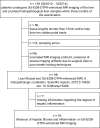Influence of hepatic fibrosis and inflammation: Correlation between histopathological changes and Gd-EOB-DTPA-enhanced MR imaging
- PMID: 31083680
- PMCID: PMC6513096
- DOI: 10.1371/journal.pone.0215752
Influence of hepatic fibrosis and inflammation: Correlation between histopathological changes and Gd-EOB-DTPA-enhanced MR imaging
Abstract
Objective: To evaluate the influence of an active inflammatory process in the liver on Gd-EOB-DTPA-enhanced MR imaging in patients with different degrees of fibrosis/cirrhosis.
Material and methods: Overall, a number of 91 patients (61 men and 30 women; mean age 58 years) were included in this retrospective study. The inclusion criteria for this study were Gd-EOB-DTPA-enhanced MRI of the liver and histopathological evaluation of fibrotic and inflammatory changes. T1-weighted VIBE sequences of the liver with fat suppression were evaluated to determine the relative signal change (RE) between native and hepatobiliary phase (20min). In simple and multiple linear regression analyses, the influence of liver fibrosis/cirrhosis (Ishak score) and the histopathological degree of hepatitis (Modified Hepatic Activity Index, mHAI) on RE were evaluated.
Results: RE decreased significantly with increasing liver fibrosis/cirrhosis (p < 0.001) and inflammation (mHAI, p = 0.004). In particular, a correlation between RE and periportal or periseptal boundary zone hepatitis (moth feeding necrosis, mHAI A, p = 0.001) and portal inflammation (mHAI D, p < 0.001) was observed. In multiple linear regression analysis, both the degree of inflammation and the degree of fibrosis were significant predictors for RE (p < 0.01).
Conclusion: The results of this study suggest that the MR-based hepatic enhancement index RE is not only influenced by the degree of fibrosis, but also by the degree of inflammation.
Conflict of interest statement
The authors have declared that no competing interests exist.
Figures






References
-
- Regev A, Berho M, Jeffers LJ, Milikowski C, Molina EG, Pyrsopoulos NT, et al. Sampling error and intraobserver variation in liver biopsy in patients with chronic HCV infection. The American journal of gastroenterology. 2002;97(10):2614–8. Epub 2002/10/19. 10.1111/j.1572-0241.2002.06038.x . - DOI - PubMed
MeSH terms
Substances
LinkOut - more resources
Full Text Sources
Medical

